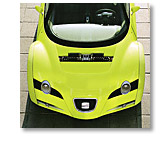

“In spirit”, says Erwin Himmel, “this car reflects the dynamism of a company that is increasingly concentrating on supplying high energy sports models to the younger motorist. And that’s exactly what the Formula does: it forcefully expresses the new character of the Seat brand. With a hint of self-mockery, but with more than a touch of a challenge”.
Entertainingly provocative, the Seat Formula slots comfortably into the fun-car niche alongside models like the Renault Spider or the Lotus Elise. No surprise then that the entire project was targeted towards the possibility of limited series production. The structure consists of an extruded aluminium space frame on which the bodywork panels of composite material are hung, a system that allowed for considerable weight reduction (the Formula weighs barely 900 kg).
The mid-rear engine is mounted on an aluminium sub-frame using unwelded pressure-cast bearings that make their own contribution to the structural rigidity of the whole. The designers opted for the 2-litre, 4-cylinder 20-valve turbo engine used on the Seat rally cars. That engine combines impressive power (240 bhp at 5800 rpm) with huge torque (295 Nm between 2100 and 4800 rpm). Factor in the light weight of the car and you get outstanding performance in terms of both top speed (235 km/h) and acceleration (0-100 km/h in 4.8 seconds).
The article continues in Auto & Design no. 116










